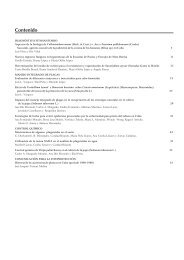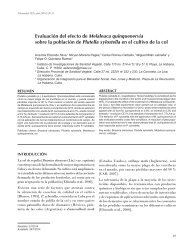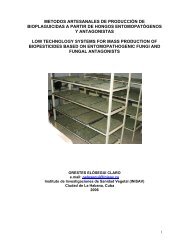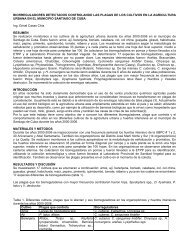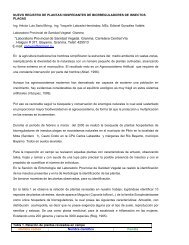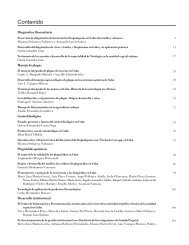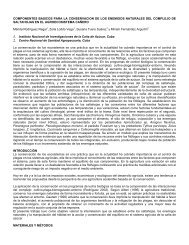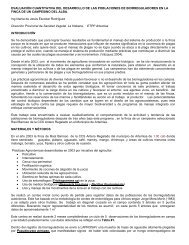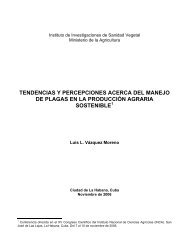Contenido - Instituto de Investigaciones de Sanidad Vegetal
Contenido - Instituto de Investigaciones de Sanidad Vegetal
Contenido - Instituto de Investigaciones de Sanidad Vegetal
You also want an ePaper? Increase the reach of your titles
YUMPU automatically turns print PDFs into web optimized ePapers that Google loves.
Estudio <strong>de</strong>l efecto protector...CONCLUSIONES• Las cepas B1, G10, Q7 y Q18 inhibieron el <strong>de</strong>sarrollo<strong>de</strong> la pudrición blanda en las rodajas inoculadas conambas concentraciones <strong>de</strong> P. carotovorum utilizadas.• Las cepas B2, G15 y G25 solamente tuvieron efectoprotector en las rodajas inoculadas con la menor concentración<strong>de</strong> P. carotovorum.• La cepa B4 produjo un incremento en la severidad<strong>de</strong> los síntomas <strong>de</strong> la enfermedad.REFERENCIASAb<strong>de</strong>l-Alim, A.; M. Mikhail; P. Laux; W. Zeller: «Biological Control ofErwinia carotovora subsp. carotovora on Potatoes by FluorescentPseudomonads and Bacillus subtilis», IOBC WPRS Bulletin, 25:139-144, 2001.Bernal, G.; A. Illanes; L. Campi: «Isolation and Partial Purification of aMetabolite from a Mutant Strain of Bacillus sp. with Antibiotic ActivityAgainst Plant Pathogenic Agents», Electronic Journal ofBiotechnology (online), vol. 5, no. 1, 2002. Disponible en http://www.ejbiotechnology.info/content/vol5/issue1/full/4/in<strong>de</strong>x.html#12Blom, T. J.: «Studies on the Epi<strong>de</strong>miology of Erwinia Soft-Rot and TheirControl in Ornamental Crops», Special Research Program, CanadaMinistry of Agriculture and Food, 2003, pp. 24-27.Estévez, A.; M. González; M. Hernán<strong>de</strong>z; J. Castillo; O. Moré; M. Cor<strong>de</strong>ro:«Estrategia para el <strong>de</strong>sarrollo <strong>de</strong>l mejoramiento <strong>de</strong> la papa»,Granma Ciencia 5:21-30, 2001.Fernán<strong>de</strong>z-Larrea, O.: «Microorganismos antagonistas para el controlfitosanitario», Manejo Integrado <strong>de</strong> plagas 62:96-100, 2001.Föl<strong>de</strong>s, T.; I. Banhegyi; Z. Varga; J. Szageti: «Isolatin of Bacillus Strainsfrom the Rhizosfere of Cereals and in vitro Screening for AntagonismAgainst Phytopathogenic, Food-Borne Pathogenic and EpoilageMicroorganisms», Journal of Applied Microbiology 89:840-845, 2000.Galán, I.: «Bacillus spp., antagonistas <strong>de</strong> las bacterias <strong>de</strong> podredumbreblanda <strong>de</strong> la papa». Tesis <strong>de</strong> Diploma, Facultad <strong>de</strong> Biología, Universidad<strong>de</strong> La Habana, 2004.Gregory, P.; H. Andra<strong>de</strong>: «Principales enfermeda<strong>de</strong>s, nematodos e insectos<strong>de</strong> la papa», CIP, 1996.Kararah, M.; F. Barakat; M. Mikhail; H. Fouly: «Pathophysiology in GarlicCloves Inoculated with Bacillus subtilis, Bacillus pumillus andErwinia carotovora», Egyptian Journal of Phyopathology 17:131-140, 1985.Ministerio <strong>de</strong> la Agricultura: «Guía técnica para la producción <strong>de</strong> papaen Cuba» <strong>Instituto</strong> <strong>de</strong> Investigación Hortícolas Liliana Dimitrova, 2000,pp. 1-37.Schallmey, M.; A. Singh; O. Ward: «Development in the Use of BacillusSpecies for Industrial Production», Canadian Journal of Microbiology50:1-17, 2004.Sharga, B.; G. Lyon: «Bacillus subtilis BS 107 as an Antagonist ofPotato Blackleg and Soft Rot Bacteria», Canadian Journal ofMicrobiology 44:777-783, 1998.US EPA: «Final Risk Assessment of Bacillus subtilis», www.epa.gov/oppt/biotech/pubs/pdf/fra009.pdf, 1997.Vanneste, J.; J. Perry; L. Perry-Meyer; R. Bedford: «Erwinia herbicolaEh252 as a Biological Control Agent of Bacterial Soft Rot on Potatoes»,NZPPS Paper 12:13-16, 1995.fitosanidad/293



